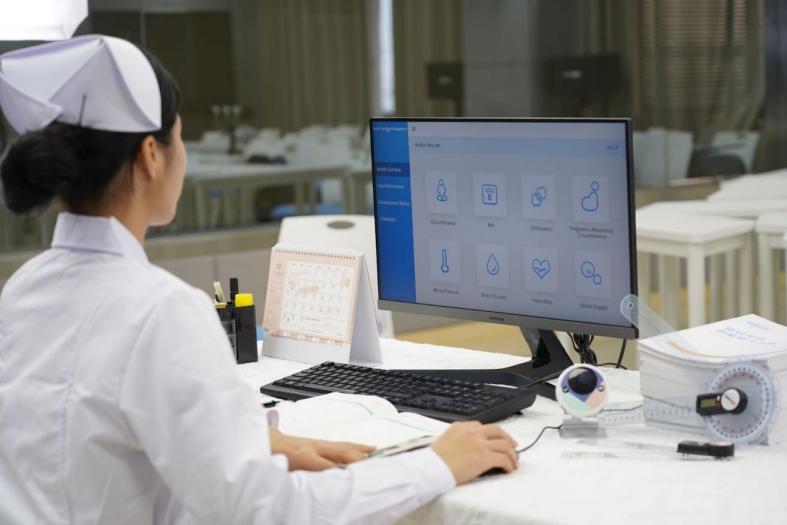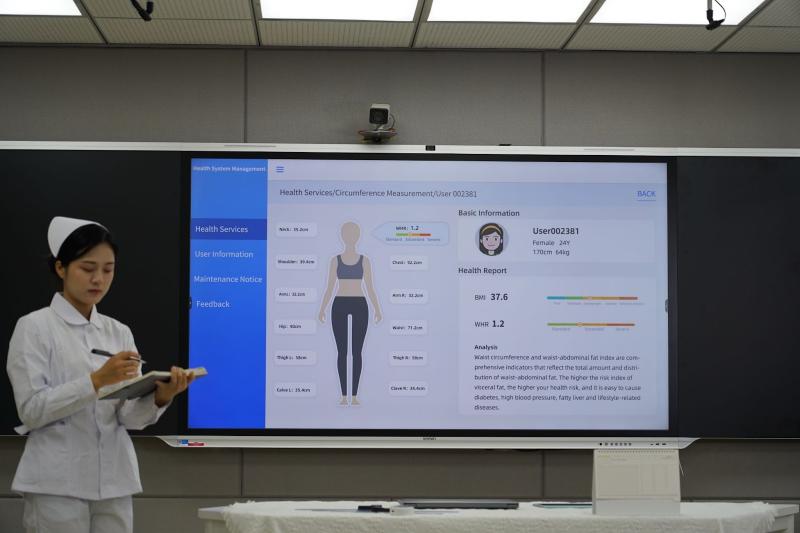GemRed Goniometer in Physical Therapy: Precision in Range of Motion Measurement
2023.09.18 / By Gemred
The measurement of Range of Motion (ROM) is a fundamental element of physical therapy, playing a pivotal role in evaluating a patient’s joint mobility and functional abilities. The comprehension of a patient’s ROM is vital for physical therapists as it enables them to diagnose musculoskeletal issues, monitor a patient’s progress throughout the rehabilitation process, and formulate effective treatment strategies. The significance of ROM measurement stems from its capacity to offer objective and quantifiable data, facilitating the establishment of realistic therapeutic goals, continual progress tracking, and ensuring optimal outcomes for individuals recovering from injuries or surgical procedures.
GemRed Goniometer in Physical Therapy is a specialized tool employed in physical therapy and rehabilitation settings for precise measurement of joint angles and Range of Motion (ROM) in patients. This device represents a notable advancement in the realm of ROM measurement, owing to its remarkable accuracy, user-friendliness, and adaptability. Distinguishing itself from conventional goniometers, the GemRed Goniometer incorporates digital technology, rendering it a valuable asset for both therapists and patients.

The Role of ROM Measurement in Physical Therapy
The Importance of ROM in Diagnosing and Managing Musculoskeletal Conditions
The measurement of Range of Motion (ROM) holds profound significance within the domain of physical therapy, particularly concerning the diagnosis and treatment of musculoskeletal disorders. ROM assessment serves as a diagnostic tool, affording physical therapists valuable insights into the scope and nature of a patient’s musculoskeletal limitations. By meticulously quantifying a patient’s joint movement capabilities, therapists can pinpoint the precise location and severity of restrictions or irregularities.
This data forms the foundation for crafting tailored treatment plans that address the unique needs of each patient. Whether the goal is to alleviate joint stiffness, rectify muscle imbalances, or guide post-operative rehabilitation, ROM measurements serve as a guiding beacon, directing therapists toward the most effective interventions. Furthermore, monitoring changes in ROM over time enables therapists to gauge the trajectory of a patient’s recovery, make necessary refinements to treatment strategies, and ensure that rehabilitation efforts remain on a path to success.
The Vital Significance of Precision and Accuracy in ROM Measurement
In the field of physical therapy, the paramount importance of precision and accuracy in ROM measurement cannot be overstated. These attributes form the bedrock of dependable data collection and, consequently, the quality of care delivered to patients. Inexact or imprecise measurements can lead to misguided diagnoses and treatment plans, potentially hindering a patient’s progress.
GemRed Goniometer, as an advanced tool, excels in this aspect by delivering unparalleled accuracy and precision. In contrast to traditional methods that often rely on manual goniometers with limited resolution, the GemRed Goniometer integrates digital technology to ensure that joint angles and ROM are measured with utmost precision. This level of accuracy empowers physical therapists to make well-informed decisions regarding treatment courses, resulting in more effective interventions and ultimately enhancing patient outcomes.
GemRed Goniometer: Features and Advantages
In-Depth Description of the GemRed Goniometer
GemRed Goniometer in Physical Therapy is a state-of-the-art device meticulously engineered for the precise measurement of joint angles and Range of Motion (ROM) in the fields of physical therapy and rehabilitation. This innovative instrument stands out due to its advanced features, rendering it an invaluable tool for healthcare professionals and patients alike.
This goniometer showcases a sleek and ergonomic design, enhancing ease of use and maneuverability during assessments. Its prominent digital display delivers immediate and highly accurate readings of joint angles, ensuring that measurements are not only dependable but also readily legible. The device incorporates an intuitive interface, simplifying its operation for both therapists and patients, even those with limited technical expertise.
One of the standout features of the GemRed Goniometer is its adaptability, as it accommodates the evaluation of a broad spectrum of joint movements across diverse anatomical regions. From assessing the knee and elbow to examining the spine and shoulder, its versatility makes it a versatile asset. Moreover, its robust construction from durable materials ensures it can endure the rigors of clinical use, guaranteeing longevity and reliability in various healthcare settings.

Advantages over Traditional Methods
The GemRed Goniometer presents a multitude of advantages when compared to conventional ROM measurement methods:
1)Digital Readout for Enhanced Precision: Diverging from manual goniometers that rely on visual estimations, the GemRed Goniometer offers digital readouts, guaranteeing precision and objectivity in measurements. This digital precision substantially diminishes the potential for errors, enabling therapists to base their decisions on reliable and accurate data.
2)Consistency in Repetitive Measurements: The GemRed Goniometer empowers therapists to attain consistency in measuring joint angles across multiple assessments. This consistency proves indispensable for tracking progress with precision over time, negating the variations that can arise with manual techniques.
3)Effortless Data Recording and Storage: The device streamlines the process of recording and archiving measurement data. Therapists can effortlessly document a patient’s progress, a particularly valuable feature for monitoring improvements or making necessary treatment adjustments.
Practical Applications in Physical Therapy
Assessment of Patients with Joint Stiffness or After Surgery
GemRed Goniometer serves as an invaluable tool in the field of physical therapy, especially when assessing patients dealing with joint stiffness or those in the post-surgery recovery phase. Patients experiencing limited joint mobility due to conditions like arthritis or postoperative restrictions require precise measurement of their Range of Motion (ROM).
By utilizing the GemRed Goniometer, physical therapists can meticulously quantify the degree of joint stiffness or track progress following surgical procedures. This data serves as the foundation for tailoring individualized treatment plans aimed at enhancing joint functionality and alleviating discomfort. The ability to monitor ROM accurately with this advanced device empowers therapists to make informed decisions regarding the intensity and direction of rehabilitation exercises, ultimately expediting the recovery process and delivering more effective care.
Monitoring Patient Progress Over Time
Another practical application of the GemRed Goniometer lies in its capacity to track patient progress throughout the course of therapy. For individuals undergoing physical therapy, consistent and objective measurements of ROM are vital for evaluating the efficacy of their treatment plan.
By utilizing the GemRed Goniometer to record and compare ROM measurements at different stages of therapy, physical therapists can assess the impact of their interventions. This tracking capability enables therapists to make necessary adjustments to the treatment plan, ensuring that it remains aligned with the patient’s evolving needs. Ultimately, the precision in monitoring progress enhances the therapist’s ability to achieve therapeutic goals and deliver customized care that maximizes patient outcomes.
Enhancing Patient Education and Engagement through Precise Measurement Data
Incorporating the GemRed Goniometer into physical therapy sessions also enhances patient education and engagement. Patients often struggle to fully comprehend the specifics of their condition or progress when relying solely on verbal explanations. However, the GemRed Goniometer’s digital readouts and objective measurements provide a visual and tangible representation of their joint mobility.
Therapists can leverage these precise measurement data as a visual aid during patient consultations. Displaying the patient’s ROM measurements on the device’s digital screen allows therapists to explain their condition and progress more comprehensively. This visual feedback not only enhances patient understanding but also fosters a sense of involvement and ownership in their rehabilitation journey. Consequently, this heightened engagement can lead to increased adherence to prescribed exercises and a more successful recovery process.
CONCLUSION
GemRed Goniometer in Physical Therapy excels in enriching patient education and engagement by presenting a tangible visualization of joint mobility. This visual representation fosters a deeper comprehension of their condition and cultivates active involvement in the rehabilitation journey.
In essence, GemRed Goniometer not only streamlines the process of ROM measurement but also elevates the standard of care provided within the realm of physical therapy and rehabilitation. Its practical utility renders it an indispensable tool, ultimately translating into enhanced patient outcomes and a more effective, patient-centric approach to therapy.
